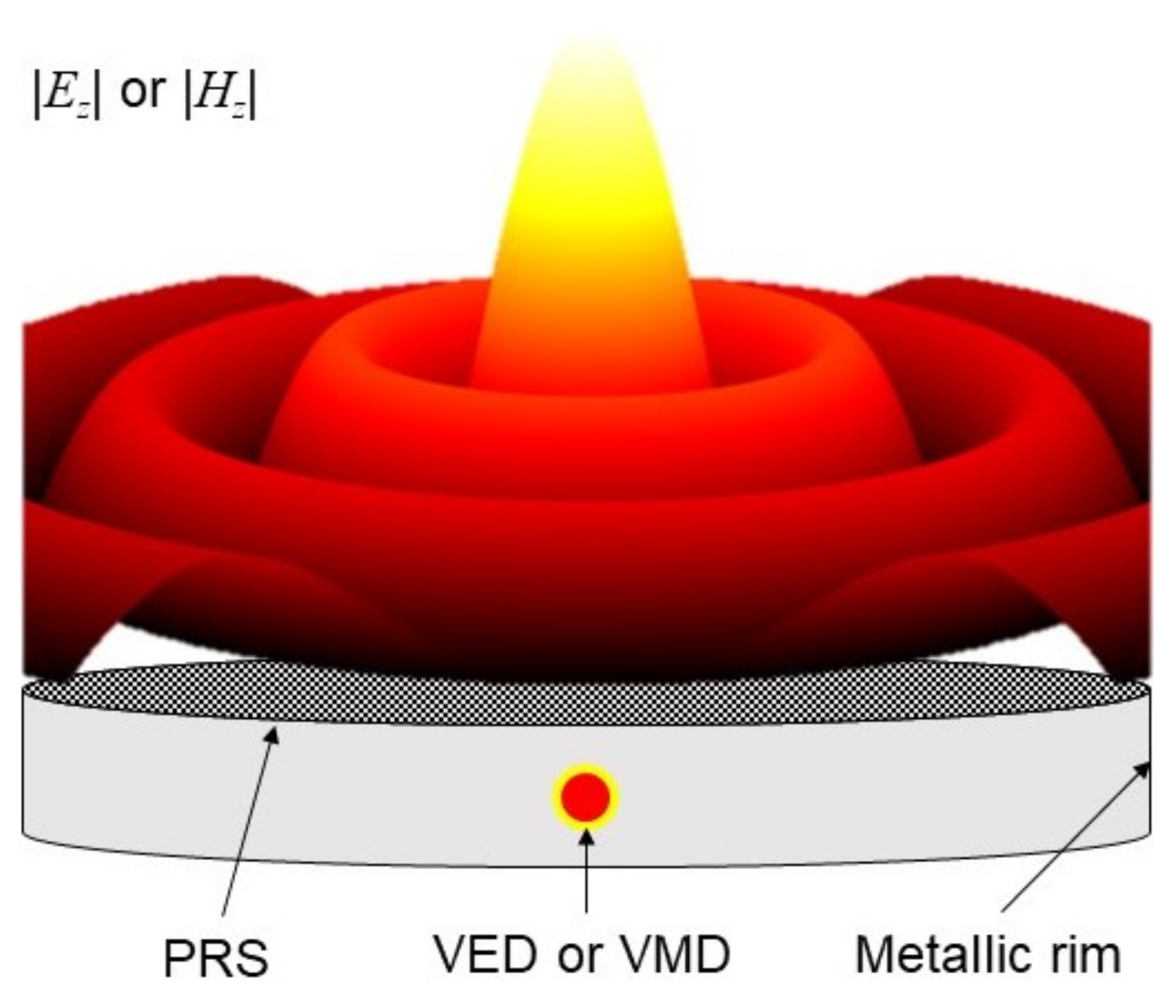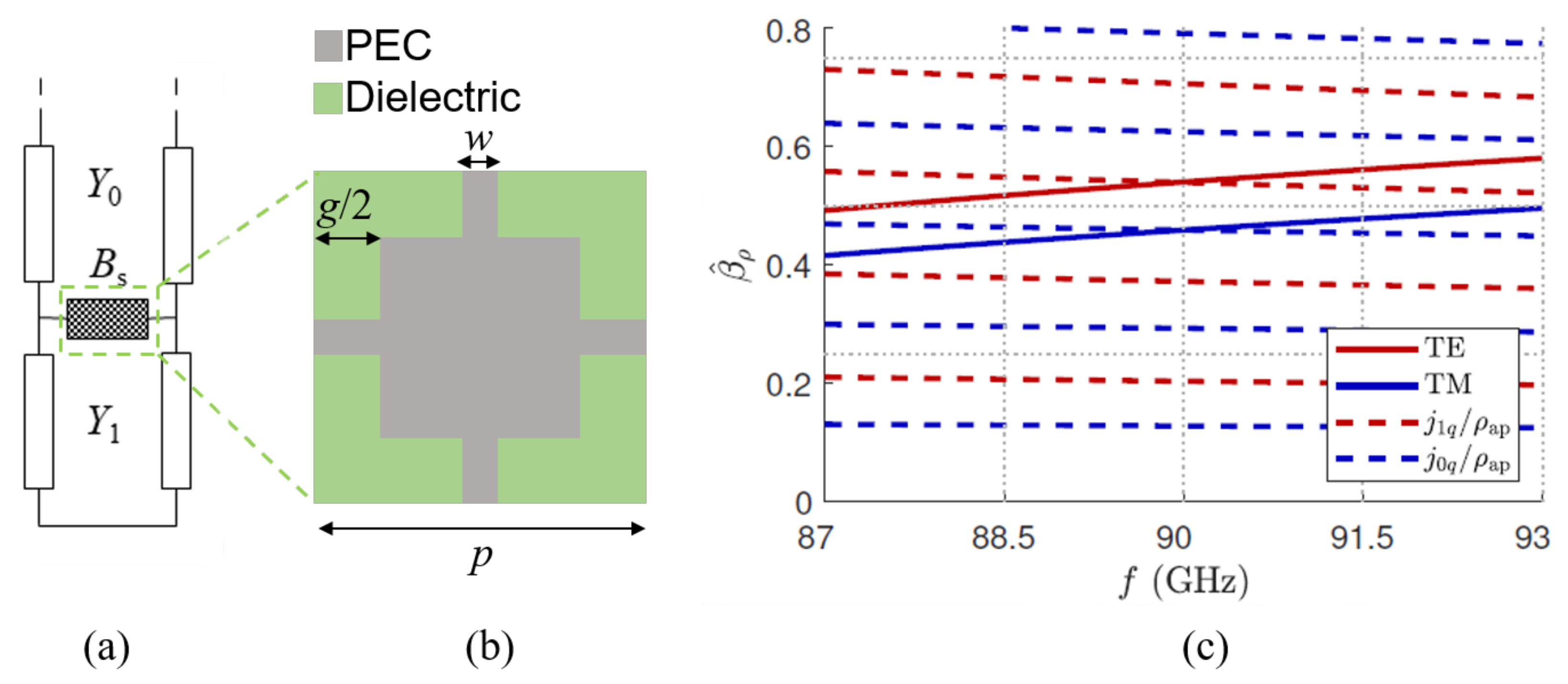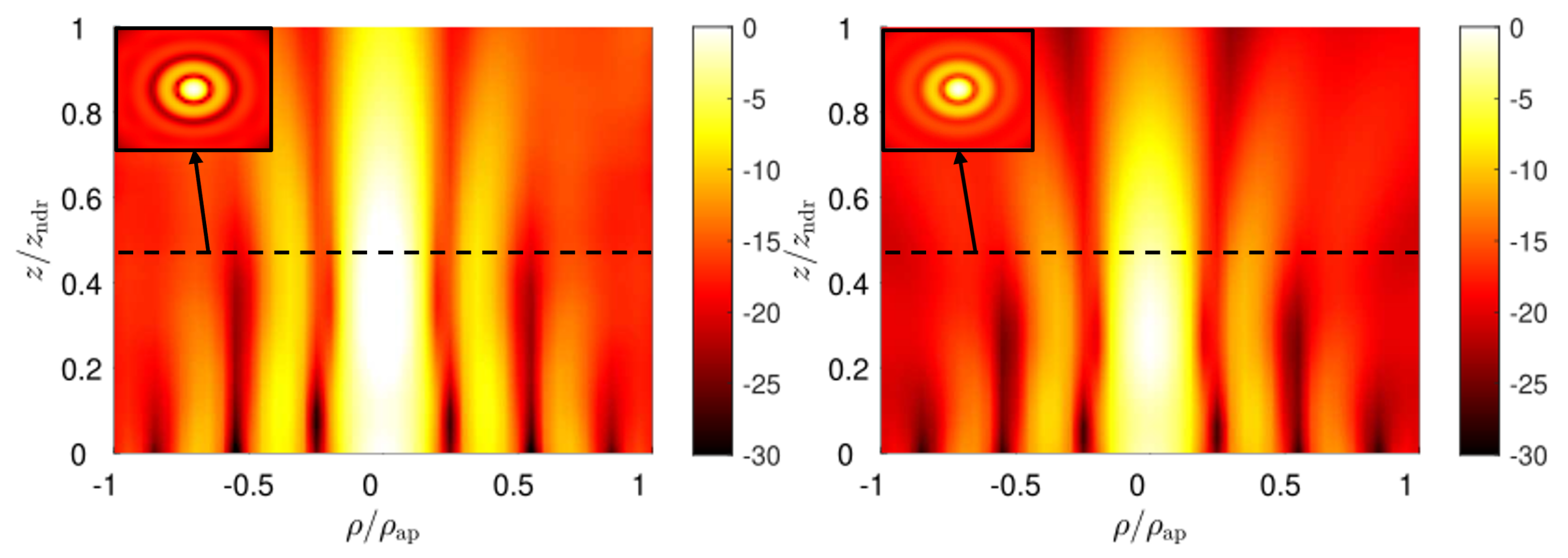A Leaky-Wave Analysis of Resonant Bessel-Beam Launchers: Design Criteria, Practical Examples, and Potential Applicationsat Microwave and Millimeter-Wave Frequencies
Abstract
1. Introduction
2. Theoretical Framework
3. Leaky-Wave Analysis
3.1. The Leaky-Wave Approach
3.2. Design Parameters
3.3. Dispersion Analysis
4. Structure Design
4.1. PRS Implementation
4.2. Feeder
4.3. Comparison between Theoretical and Full-Wave Results
5. Applications
6. Conclusions
Author Contributions
Funding
Data Availability Statement
Conflicts of Interest
Abbreviations
| LWA | Leaky-Wave Antenna |
| PCB | Printed-Circuit Board |
| PEC | Perfect Electric Conductor |
| PRS | Partially Reflecting Sheet |
| TE | Transverse Electric |
| TM | Transverse Magnetic |
| VED | Vertical Electric Dipole |
| VMD | Vertical Magnetic Dipole |
| WPT | Wireless Power Transfer |
References
- Hernández-Figueroa, H.E.; Zamboni-Rached, M.; Recami, E. Localized Waves; John Wiley & Sons: Hoboken, NJ, USA, 2007. [Google Scholar]
- Hernández-Figueroa, H.E.; Zamboni-Rached, M.; Recami, E. Nondiffracting Waves; John Wiley & Sons: Weinheim, Germany, 2013. [Google Scholar]
- McGloin, D.; Dholakia, K. Bessel beams: Diffraction in a new light. Contemporary Phys. 2005, 46, 15–28. [Google Scholar] [CrossRef]
- Ettorre, M.; Pavone, S.C.; Casaletti, M.; Albani, M.; Mazzinghi, A.; Freni, A. Near-field focusing by non-diffracting Bessel beams. In Aperture Antennas for Millimeter and Sub-Millimeter Wave Applications; Springer: Cham, Switzerland, 2018; pp. 243–288. [Google Scholar]
- Ettorre, M.; Grbic, A. Generation of propagating Bessel beams using leaky-wave modes. IEEE Trans. Antennas Propag. 2012, 60, 3605–3613. [Google Scholar] [CrossRef]
- Fuscaldo, W.; Valerio, G.; Galli, A.; Sauleau, R.; Grbic, A.; Ettorre, M. Higher-order leaky-mode Bessel-beam launcher. IEEE Trans. Antennas Propag. 2016, 64, 904–913. [Google Scholar] [CrossRef]
- Comite, D.; Fuscaldo, W.; Podilchak, S.K.; Hílario-Re, P.D.; Gómez-Guillamón Buendía, V.; Burghignoli, P.; Baccarelli, P.; Galli, A. Radially periodic leaky-wave antenna for Bessel beam generation over a wide-frequency range. IEEE Trans. Antennas Propag. 2018, 66, 2828–2843. [Google Scholar] [CrossRef]
- Chiotellis, N.; Mendez, V.; Rudolph, S.M.; Grbic, A. Experimental demonstration of highly localized pulses (X waves) at microwave frequencies. Phys. Rev. B 2018, 97, 085136. [Google Scholar] [CrossRef]
- Chiotellis, N.; Zhang, S.; Vardaxoglou, Y.C.; Grbic, A. X wave radiator implemented with 3D printed metamaterials. IEEE Trans. Antennas Propag. 2020, 68, 5478–5486. [Google Scholar] [CrossRef]
- Ettorre, M.; Rudolph, S.M.; Grbic, A. Generation of propagating Bessel beams using leaky-wave modes: Experimental validation. IEEE Trans. Antennas Propag. 2012, 60, 2645–2653. [Google Scholar] [CrossRef]
- Fuscaldo, W.; Burghignoli, P.; Galli, A. Genealogy of leaky, surface, and plasmonic modes in partially open waveguides. Phys. Rev. Appl. 2022, 17, 034038. [Google Scholar] [CrossRef]
- Pozar, D.M. Microwave Engineering; John Wiley & Sons: Hoboken, NJ, USA, 2009. [Google Scholar]
- Lu, P.; Voyer, D.; Bréard, A.; Huillery, J.; Allard, B.; Lin-Shi, X.; Yang, X.S. Design of TE-polarized Bessel antenna in microwave range using leaky-wave modes. IEEE Trans. Antennas Propag. 2017, 66, 32–41. [Google Scholar] [CrossRef]
- Lu, P.; Bréard, A.; Huillery, J.; Yang, X.S.; Voyer, D. Feeding coils design for TE-polarized Bessel antenna to generate rotationally symmetric magnetic field distribution. IEEE Antennas Wirel. Propag. Lett. 2018, 17, 2424–2428. [Google Scholar] [CrossRef]
- Negri, E.; Fuscaldo, W.; Ettorre, M.; Burghignoli, P.; Galli, A. Analysis of resonant Bessel-beam launchers based on isotropic metasurfaces. In Proceedings of the 16th European Conference on Antennas and Propagation (EuCAP 2022), Madrid, Spain, 27 March–1 April 2022; pp. 1–4. [Google Scholar]
- Heebl, J.D.; Ettorre, M.; Grbic, A. Wireless links in the radiative near field via Bessel beams. Phys. Rev. Appl. 2016, 6, 034018. [Google Scholar] [CrossRef]
- Negri, E.; Benassi, F.; Fuscaldo, W.; Masotti, D.; Burghignoli, P.; Costanzo, A.; Galli, A. Effective TE-polarized Bessel-beam excitation for wireless power transfer near-field links. In Proceedings of the 52nd European Microwave Conference (EuMC), Milan, Italy, 25–30 September 2022; pp. 1–4. [Google Scholar]
- Zamboni-Rached, M.; Recami, E.; Hernández-Figueroa, H.E. New localized superluminal solutions to the wave equations with finite total energies and arbitrary frequencies. Eur. Phys. J. D 2002, 21, 217–228. [Google Scholar] [CrossRef]
- Durnin, J.; Miceli, J.J., Jr.; Eberly, J.H. Diffraction-free beams. Phys. Rev. Lett. 1987, 58, 1499. [Google Scholar] [CrossRef]
- Durnin, J. Exact solutions for nondiffracting beams. I. The scalar theory. J. Opt. Soc. Am. A 1987, 4, 651–654. [Google Scholar] [CrossRef]
- Fuscaldo, W.; Pavone, S.C. Metrics for localized beams and pulses. IEEE Trans. Antennas Propag. 2020, 68, 1176–1180. [Google Scholar] [CrossRef]
- Galli, A.; Baccarelli, P.; Burghignoli, P. Leaky-Wave Antennas. Wiley Enc. Electric. Electron. Eng. 2016, 2016, 1–20. [Google Scholar]
- Tamir, T.; Oliner, A.A. Guided complex waves. Part 1: Fields at an interface. Proc. IEE 1963, 110, 310–324. [Google Scholar] [CrossRef]
- Tamir, T.; Oliner, A.A. Guided complex waves. Part 2: Relation to radiation patterns. Proc. IEE 1963, 110, 325–334. [Google Scholar] [CrossRef]
- Burghignoli, P.; Fuscaldo, W.; Comite, D.; Baccarelli, P.; Galli, A. Higher-order cylindrical leaky waves–Part I: Canonical sources and radiation formulas. IEEE Trans. Antennas Propag. 2019, 67, 6735–6747. [Google Scholar] [CrossRef]
- Felsen, L. Real spectra, complex spectra, compact spectra. J. Opt. Soc. Am. A 1986, 3, 486–496. [Google Scholar] [CrossRef]
- Luukkonen, O.; Simovski, C.; Granet, G.; Goussetis, G.; Lioubtchenko, D.; Raisanen, A.V.; Tretyakov, S.A. Simple and accurate analytical model of planar grids and high-impedance surfaces comprising metal strips or patches. IEEE Trans. Antennas Propag. 2008, 56, 1624–1632. [Google Scholar] [CrossRef]
- Fuscaldo, W.; Tofani, S.; Zografopoulos, D.C.; Baccarelli, P.; Burghignoli, P.; Beccherelli, R.; Galli, A. Systematic design of THz leaky-wave antennas based on homogenized metasurfaces. IEEE Trans. Antennas Propag. 2018, 66, 1169–1178. [Google Scholar] [CrossRef]
- Benassi, F.; Fuscaldo, W.; Masotti, D.; Galli, A.; Costanzo, A. Wireless power transfer in the radiative near-field through resonant Bessel-beam launchers at millimeter Waves. In Proceedings of the 2021 IEEE Wireless Power Transfer Conference (WPTC), San Diego, CA, USA, 1–4 June 2021; pp. 1–4. [Google Scholar]
- Fuscaldo, W.; Galli, A.; Jackson, D.R. Optimization of 1-D unidirectional leaky-wave antennas based on partially reflecting sheets. IEEE Trans. Antennas Propag. 2022, 70, 7853–7868. [Google Scholar] [CrossRef]
- Lovat, G.; Burghignoli, P.; Jackson, D.R. Fundamental properties and optimization of broadside radiation from uniform leaky-wave antennas. IEEE Trans. Antennas Propag. 2006, 54, 1442–1452. [Google Scholar] [CrossRef]
- Sorrentino, R.; Mongiardo, M. Transverse resonance techniques. In Encyclopedia of RF and Microwave Engineering; John Wiley & Sons, Ltd: Hoboken, NJ, USA, 2005. [Google Scholar]
- Benassi, F.; Fuscaldo, W.; Negri, E.; Paolini, G.; Augello, E.; Masotti, D.; Burghignoli, P.; Galli, A.; Costanzo, A. Comparison between hybrid- and TM-polarized Bessel-beam launchers for wireless power transfer in the radiative near-field at millimeter waves. In Proceedings of the 51st European Microwave Conference (EuMC 2021), London, UK, 4–6 April 2022; pp. 1–4. [Google Scholar]
- Burghignoli, P.; Fuscaldo, W.; Galli, A. Fabry–Perot cavity antennas: The leaky-wave perspective. IEEE Antennas Propag. Mag. 2021, 63, 116–145. [Google Scholar] [CrossRef]
- Xu, Y.; Peng, T.; Sun, M.; Luo, Y.; Wang, J.; Jiang, W.; Liu, G.; Wu, Z. Design and test of broadband rectangular waveguide TE10 to circular waveguide TE21 and TE01 mode converters. IEEE Trans. Electron Devices 2019, 66, 3573–3579. [Google Scholar] [CrossRef]
- Chu, Q.X.; Mo, D.Y.; Wu, Q.S. An isolated radial power divider via circular waveguide TE01-mode transducer. IEEE Trans. Microw. Theory Tech. 2015, 63, 3988–3996. [Google Scholar] [CrossRef]
- Paković, S.; Zhou, S.; González-Ovejero, D.; Pavone, S.C.; Grbic, A.; Ettorre, M. Bessel–Gauss beam launchers for wireless power transfer. IEEE Open J. Antennas Propag. 2021, 2, 654–663. [Google Scholar] [CrossRef]
- CST Studio Suite. Electromagnetic Field Simulation Software, Dassault Systèmes. Available online: https://www.3ds.com/products-services/simulia/products/cst-studio-suite/ (accessed on 1 October 2022).
- Balanis, C.A. Advanced Engineering Electromagnetics; Wiley: Hoboken, NJ, USA, 2012. [Google Scholar]
- Ruschin, S. Modified Bessel nondiffracting beams. J. Opt. Soc. Am. A 1994, 11, 3224–3228. [Google Scholar] [CrossRef]
- Stsepuro, N.; Nosov, P.; Galkin, M.; Krasin, G.; Kovalev, M.; Kudryashov, S. Generating Bessel-Gaussian beams with controlled axial intensity distribution. Appl. Sci. 2020, 10, 7911. [Google Scholar] [CrossRef]
- Abielmona, S.; Gupta, S.; Caloz, C. Compressive receiver using a CRLH-based dispersive delay line for analog signal processing. IEEE Trans. Microw. Theory Tech. 2009, 57, 2617–2626. [Google Scholar] [CrossRef]
- Fuscaldo, W.; Benedetti, A.; Comite, D.; Baccarelli, P.; Burghignoli, P.; Galli, A. Bessel-Gauss beams through leaky waves: Focusing and diffractive properties. Phys. Rev. Appl. 2020, 13, 064040. [Google Scholar] [CrossRef]
- Pavone, S.C.; Sorbello, G.; Di Donato, L. Improving physical optics approximation through Bessel beam scattering. IEEE Antennas Wirel. Propag. Lett. 2021, 20, 993–997. [Google Scholar] [CrossRef]
- Chen, S.; Li, S.; Zhao, Y.; Liu, J.; Zhu, L.; Wang, A.; Du, J.; Shen, L.; Wang, J. Demonstration of 20-Gbit/s high-speed Bessel beam encoding/decoding link with adaptive turbulence compensation. Opt. Lett. 2016, 41, 4680–4683. [Google Scholar] [CrossRef]
- Arlt, J.; Garcés-Chávez, V.; Sibbett, W.; Dholakia, K. Optical micromanipulation using a Bessel light beam. Opt. Commun. 2001, 197, 239–245. [Google Scholar] [CrossRef]
- Lee, K.S.; Rolland, J.P. Bessel beam spectral-domain high-resolution optical coherence tomography with micro-optic axicon providing extended focusing range. Opt. Lett. 2008, 33, 1696–1698. [Google Scholar] [CrossRef]
- Planchon, T.A.; Gao, L.; Milkie, D.E.; Davidson, M.W.; Galbraith, J.A.; Galbraith, C.G.; Betzig, E. Rapid three-dimensional isotropic imaging of living cells using Bessel beam plane illumination. Nat. Methods 2011, 8, 417–423. [Google Scholar] [CrossRef]
- Liu, C.; Zhao, Z.; Jin, C.; Xiao, Y.; Gao, G.; Xie, H.; Dai, Q.; Yin, H.; Kong, L. High-speed, multi-modal, label-free imaging of pathological slices with a Bessel beam. Biomed. Opt. Express 2020, 11, 2694–2704. [Google Scholar] [CrossRef]
- Mugnai, D.; Spalla, P. Electromagnetic propagation of Bessel-like localized waves in the presence of absorbing media. Opt. Commun. 2009, 282, 4668–4671. [Google Scholar] [CrossRef]
- Mazzinghi, A.; Balma, M.; Devona, D.; Guarnieri, G.; Mauriello, G.; Albani, M.; Freni, A. Large depth of field pseudo-Bessel beam generation with a RLSA antenna. IEEE Trans. Antennas Propag. 2014, 62, 3911–3919. [Google Scholar] [CrossRef]
- Feng, R.; Ratni, B.; Yi, J.; Jiang, Z.; Zhang, H.; de Lustrac, A.; Burokur, S.N. Flexible manipulation of Bessel-like beams with a reconfigurable metasurface. Adv. Opt. Mat. 2020, 8, 2001084. [Google Scholar] [CrossRef]
- Fuscaldo, W.; Pavone, S.C. Tunable terahertz Bessel-beam launchers. Rev. Electromagn. 2022, 1, 1–4. [Google Scholar] [CrossRef]
- Bitman, A.; Moshe, I.; Zalevsky, Z. Improving depth-of field in broadband THz beams using nondiffractive Bessel beams. Opt. Lett. 2012, 37, 4164–4166. [Google Scholar] [CrossRef] [PubMed]
- Winnerl, S.; Zimmermann, B.; Peter, F.; Schneider, H.; Helm, M. Terahertz Bessel-Gauss beams of radial and azimuthal polarization from microstructured photoconductive antennas. Opt. Express 2009, 17, 1571–1576. [Google Scholar] [CrossRef] [PubMed]
- Monnai, Y.; Jahn, D.; Withayachumnankul, W.; Koch, M.; Shinoda, H. Terahertz plasmonic Bessel beamformer. Appl. Phys. Lett. 2015, 106, 021101. [Google Scholar] [CrossRef]
- Yu, Y.Z.; Dou, W.B. Production of THz pseudo-Bessel beams with uniform axial intensity using irregular binary axicons. IET Optoelectron. 2010, 4, 195–200. [Google Scholar] [CrossRef]
- Garnica, J.; Chinga, R.A.; Lin, J. Wireless power transmission: From far field to near field. Proc. IEEE 2013, 101, 1321–1331. [Google Scholar] [CrossRef]
- Jolani, F.; Yu, Y.; Chen, Z. A planar magnetically coupled resonant wireless power transfer system using printed spiral coils. IEEE Antennas Wirel. Propag. Lett. 2014, 13, 1648–1651. [Google Scholar] [CrossRef]
- Gowda, V.R.; Yurduseven, O.; Lipworth, G.; Zupan, T.; Reynolds, M.S.; Smith, D.R. Wireless power transfer in the radiative near field. IEEE Antennas Wirel. Propag. Lett. 2016, 15, 1865–1868. [Google Scholar] [CrossRef]
- Fuscaldo, W.; Comite, D.; Boesso, A.; Beccarelli, P.; Burghignoli, P.; Galli, A. Focusing leaky waves: A class of electromagnetic localized waves with complex spectra. Phys. Rev. Appl. 2018, 9, 054005. [Google Scholar] [CrossRef]
- Pavone, S.C.; Ettorre, M.; Casaletti, M.; Albani, M. Transverse circular-polarized Bessel beam generation by inward cylindrical aperture distribution. Opt. Express 2016, 24, 11103–11111. [Google Scholar] [CrossRef]
- Pavone, S.C.; Ettorre, M.; Albani, M. Analysis and design of Bessel beam launchers: Longitudinal polarization. IEEE Trans. Antennas Propag. 2016, 64, 2311–2318. [Google Scholar] [CrossRef]






| Admittance | TE | TM |
|---|---|---|
| Polarization | h (mm) | |||||
|---|---|---|---|---|---|---|
| TE | 0.5401 | 0.0019 | 30 | 1.94 | 0.2086 | 0.05 |
| TM | 0.4588 | 0.0020 | 20 | 1.84 | 0.1732 | 0.1 |
Publisher’s Note: MDPI stays neutral with regard to jurisdictional claims in published maps and institutional affiliations. |
© 2022 by the authors. Licensee MDPI, Basel, Switzerland. This article is an open access article distributed under the terms and conditions of the Creative Commons Attribution (CC BY) license (https://creativecommons.org/licenses/by/4.0/).
Share and Cite
Negri, E.; Fuscaldo, W.; Burghignoli, P.; Galli, A. A Leaky-Wave Analysis of Resonant Bessel-Beam Launchers: Design Criteria, Practical Examples, and Potential Applicationsat Microwave and Millimeter-Wave Frequencies. Micromachines 2022, 13, 2230. https://doi.org/10.3390/mi13122230
Negri E, Fuscaldo W, Burghignoli P, Galli A. A Leaky-Wave Analysis of Resonant Bessel-Beam Launchers: Design Criteria, Practical Examples, and Potential Applicationsat Microwave and Millimeter-Wave Frequencies. Micromachines. 2022; 13(12):2230. https://doi.org/10.3390/mi13122230
Chicago/Turabian StyleNegri, Edoardo, Walter Fuscaldo, Paolo Burghignoli, and Alessandro Galli. 2022. "A Leaky-Wave Analysis of Resonant Bessel-Beam Launchers: Design Criteria, Practical Examples, and Potential Applicationsat Microwave and Millimeter-Wave Frequencies" Micromachines 13, no. 12: 2230. https://doi.org/10.3390/mi13122230
APA StyleNegri, E., Fuscaldo, W., Burghignoli, P., & Galli, A. (2022). A Leaky-Wave Analysis of Resonant Bessel-Beam Launchers: Design Criteria, Practical Examples, and Potential Applicationsat Microwave and Millimeter-Wave Frequencies. Micromachines, 13(12), 2230. https://doi.org/10.3390/mi13122230









